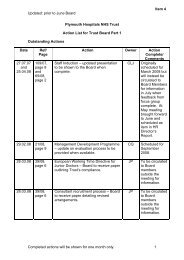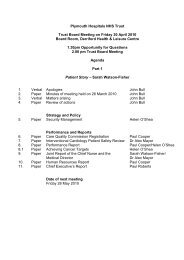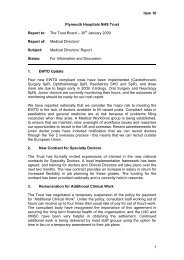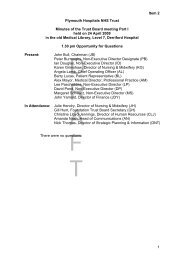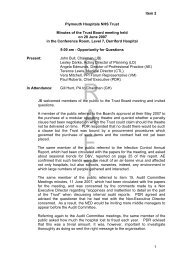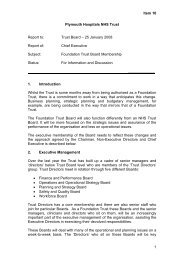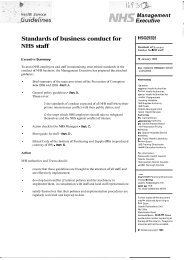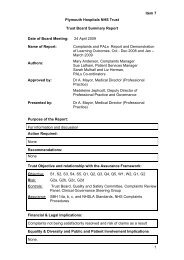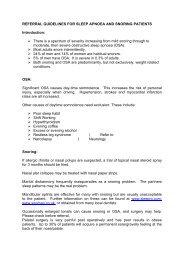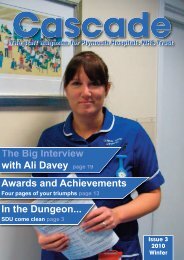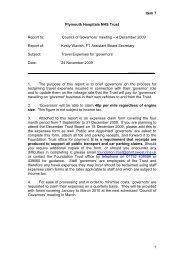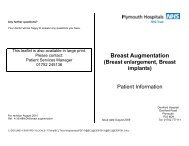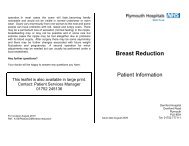Agenda and supporting papers - Plymouth Hospitals NHS Trust
Agenda and supporting papers - Plymouth Hospitals NHS Trust
Agenda and supporting papers - Plymouth Hospitals NHS Trust
Create successful ePaper yourself
Turn your PDF publications into a flip-book with our unique Google optimized e-Paper software.
Item 15, Annex 1<br />
• Top three issues raised through PALS remain as communication, inpatient delays<br />
<strong>and</strong> outpatient delays. Although communication remains a top theme there are no<br />
particular areas of concern that could be addressed which would show an<br />
improvement in the overall figures of these issues<br />
• A particular piece of work in relation to communication is being completed with those<br />
who are visually <strong>and</strong> hearing impaired so that feedback can be used to drive<br />
improvements for these care pathways. AJ suggested doing the same with patients<br />
who suffer with learning difficulties<br />
• The FFT response continues to improve <strong>and</strong> run charts will be included within the<br />
report from next month. The <strong>Trust</strong> is currently achieving a response rate of 13.5%.<br />
Some wards have achieved a 40-50% response rate whilst others have only<br />
achieved 4%. Implementation of FFT within good performing areas will be shared to<br />
ensure the response rates are increased.<br />
The Chair noted that a significant number of the PALS <strong>and</strong> complaints received within<br />
the <strong>Trust</strong> relate to the Gastroenterology, Surgery <strong>and</strong> Renal directorate. JG explained the<br />
key issues within this area relate to patient access to treatment for example, a number of<br />
patients are informed they will be reviewed within 4-6 weeks but the waiting list within the<br />
directorate is 12 weeks at that stage. RB noted that there is a strong correlation to the<br />
follow-up backlog as this directorate account for half of the admitted follow-up backlog.<br />
The Committee took assurance from the content of the report <strong>and</strong> asked that actions<br />
were taken to reduce the PALS <strong>and</strong> complaint levels in Surgery.<br />
JG<br />
8. Safe Care Report<br />
AM presented the Safe Care Report to the Committee <strong>and</strong> highlighted the following key<br />
points –<br />
• The HSMR <strong>and</strong> SHMI data demonstrates the <strong>Trust</strong> is maintaining good rates<br />
• In February 2013 VTE cases were identified <strong>and</strong> each patient had received the<br />
appropriate treatment, although 93% of these cases received the appropriate risk<br />
assessment<br />
• The four yearly GTT report shows there has been a continual reduction in harm<br />
caused to patients. Areas identified consistently with top three areas of harm are<br />
wound infections, pressure ulcers <strong>and</strong> hospital acquired pneumonia. All of these are<br />
currently being addressed through ongoing work programmes<br />
The Chair asked whether specific improvement areas from the Regional Patient Safety<br />
Initiative will be incorporate within the overarching quality improvement action plan. AM<br />
explained that service line leads will be expected to lead on particular improvements<br />
however, <strong>Trust</strong> wide issues will be monitored at sub-committee or committee level. GTT<br />
is an indicated of where the efforts of the Trist must be focused.<br />
The Chair highlighted inpatient falls as a particular issue <strong>and</strong> explained that a particular<br />
piece of work regarding intentional rounding was completed at RD&E Hospital <strong>and</strong> this<br />
appeared to have a significant impact on the number of falls. GD added that the<br />
implementation of intentional rounding was re-launched at Taunton hospital as it became<br />
a tick box exercise. Within two years of this re-launch there was a 30% reduction in the<br />
number of inpatient falls. The Chair emphasised the importance of ensuring this is<br />
implemented properly within the <strong>Trust</strong> <strong>and</strong> that there is culture change. For this to<br />
happen within the hospital there needs to be clear leadership. GD <strong>and</strong> DH are working<br />
on getting intentional rounding used within the <strong>Trust</strong> which will reduce falls <strong>and</strong> improve<br />
nursing care.<br />
GD/DH<br />
9. Assurance Framework<br />
LB presented a new Quality Assurance Framework to the Committee <strong>and</strong> asked for their<br />
comments <strong>and</strong> whether any risks were felt to be missing.<br />
The Committee asked that the following comments <strong>and</strong> risks were incorporated within<br />
the framework –<br />
S&Q Draft Minutes June 13 Page 4 of 7<br />
LB



